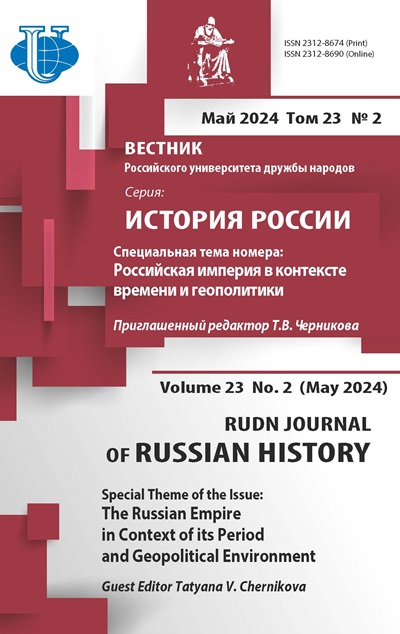Searching for Forms and Methods of Acting on Indigenous Population by Turkestan Soviet and Communist Party Bodies in the Context of Fighting the Basmachi in 1918-1924
- Authors: Barmin V.A.1
-
Affiliations:
- Altai State Pedagogical University
- Issue: Vol 22, No 1 (2023): The Peoples of Russia in the System of Transnational Relations in Siberia, China and Central Asia
- Pages: 97-109
- Section: THE PEOPLES OF RUSSIA IN THE SYSTEM OF TRANSNATIONAL RELATIONS IN SIBERIA, CHINA AND CENTRAL ASIA
- URL: https://journals.rudn.ru/russian-history/article/view/33903
- DOI: https://doi.org/10.22363/2312-8674-2023-22-1-97-109
Cite item
Full text / tables, figures
Abstract
The protest movement of the Turkestani indigenous population against the Soviet rule known in history as “Basmachi movement” became the most important stage of the Civil War in the Central Asian territory of the former Russian Empire. This phenomenon, complicated in terms of motivating features, social composition, and ideological dimensions, had been researched throughout the entire period of Soviet Union. However, the researchers were conditioned by rigid ideological framework, the ban on access to documental sources, and several other restrictions, that excluded the possibility to provide unbiased objective assessment of the Basmachi phenomenon. Questions relating to the true causes of the movement, and specifically those that disclosed the support to the movement from the majority of Turkestani population, remained beyond the research scope. The collapse of the USSR, the access to formerly classified closed archives made it possible to largely change the view on the history of this popular protest. In the proposed paper, the author’s research is supported by materials from newly identified sources in the holdings of the Russian State Military Archive and the Russian State Archive of Socio-Political History. The author claims in the paper that a significant part of the causes that boosted the scale of the movement and its support from the population resulted from gross mistakes of the Soviet government in socio-political reforms and especially in matters of nationalities policy. Correcting these mistakes, applying new forms and methods of acting on indigenous peoples made it possible for Bolsheviks to gain the victory over the Basmachi and bring the internal political situation in the region to stability.
About the authors
Valeriy A. Barmin
Altai State Pedagogical University
Author for correspondence.
Email: valbarmin@mail.ru
Dr. Habil. Hist., Professor of the General History Department of the Institute of History, Social Communications and Law 55, Molodezhnaya Str., Barnaul, 656031, Russia
References
- Agzamkhodzhaev, S.S. Istoriia Turkestanskoi avtonomii (Turkiston mukhtoriyati) [History of Turkestani Autonomous Region]. Tashkent: Toashkent Islom University Publ., 2006 (in Russian).
- Barmin, V.A. “Several Reasons for Emergence of the Basmachi Movement in Turkestan in 1918-1923.” Tomsk State University Journal of History, no. 53 (2018): 88-92 (in Russian).
- Blyakher, L.E., and Yarulin, I.F. “Kto takie basmachi? Sovetskoe mifotvorchestvo i stigmatizatsiya Grazhdanskoi voiny v Srednei Azii [Who are the Basmachis? Soviet mythmaking and stigmatization of the Civil War in Central Asia].” Politiya: Analiz. Khronika. Prognoz, no. 2 (2016): 109-123 (in Russian).
- Danil'chenko, S.L. “Geopoliticheskaia strategiia I.V. Stalina po upravleniiu natsional'nymi okrainami SSSR: sushchnost' i istoki [Joseph Stalin’s Geopolitical Strategy on the Management of the National Outskirts of the USSR: Essence and Origin].” Nauchnye issledovaniia: ot teorii k praktike: materialy VII Mezhdunar. nauch.-prakt. konf. (Cheboksary, 13 mart 2016 g.), 19-30. Cheboksary: Interaktiv plus Publ., 2016 (in Russian).
- Eshchanova, I.K. “Surplus-Appropriation and Uzbek Dechkanstvo.” RUDN Journal of Russian History, no. 2 (2007): 105-110 (in Russian).
- Kudukhov, K.S. “Deiatel'nost' Soveta internatsional'noi propagandy na Vostoke v 1920 g. [Activities of the International Propaganda Council in the Orient in 1920].” Vostochnyi arkhiv, no. 1 (2011): 61-67 (in Russian).
- Lysenko, Yu.A., Barmin, V.A., Anisimova, et al. Etnopoliticheskie protsessy v Tsentral'noaziatskikh okrainakh Rossii v period revoliutsii 1917 g. [Ethnopolitical processes in the Central Asian outskirts of Russia during the revolutions of 1917]. Barnaul: AltGU Publishing House, 2017 (in Russian).
- Mikhailov, V.F. “Khronika velikogo dzhuta [Chronicles of the Great Jute].” Iunost', no. 1 (1990): 83-84 (in Russian).
- Narbekov, S.F., and Norbekova, R.U. “Vooruzhennoe vosstanie narodov Turkestana protiv sovetskogo rezhima, ego prichiny i posledstviya [Turkestani people’s armed uprising against the Soviet rule, its causes and consequences].” Aktual'nye nauchnye issledovaniya v sovremennom mire. № 1-4 (2017): 34-40 (in Russian).
- Ponomarev, V.A. “K voprosu o genotside armianskogo naroda v Turtsii i Zakavkaz'e XIX-XX vv. [On the Problem of Armenian Genocide in Turkey and Transcaucasia in the 19th-20th Centuries].” Tomsk State University Journal of History, no. 320 (2009): 119-122 (in Russian).
- Pylev, A.I. “Ob ideologicheskikh techeniyakh basmacheskogo dvizheniya v Srednei Azii v nachal'nyi period (1918-1920 gg.) [Ideology of the Basmachi Movement in Middle Asia (1918-1929)].” Bulletin of St. Petersburg University. Series 2 2, no. 10, (2003): 29-33 (in Russian).
- Radzhabov, K.K. “Vooruzhennoe dvizhenie protiv Sovetskoi vlasti v Turkestane (1918-1935 gg.) [Armed Movement against Soviet Power in Turkestan].” In Edinstvo. Grazhdanstvennost'. Patriotizm. Sbornik nauchnykh trudov k 100-letiyu Respubliki Bashkortostan, 27-31. Ufa: Mir Pechati Publ., 2019 (in Russian).
- Sadykova, N.T. “Bor'ba s sovetskoi vlast'yu na yuge Kyrgyzstana [Fighting Soviet Rule in the South of Kyrgyzstan].” Nauka, novye tekhnologii i innovatsii Kyrgyzstana, no. 11 (2016): 108-110 (in Russian).
- Solodova, G.S. “Governance of the Turkestan Region: Some Principles.” Vestnik Tomskogo Gosudarstvennogo Universiteta. Filosofiya. Sotsiologiya. Politologiya - Tomsk State University Journal of Philosophy, Sociology and Political Science, no. 51 (2019): 158-166 (in Russian).
- Xexter, J.H. On historians: Reappraisals of the makers of modern history. Cambridge: Harvard University Press, 1979.
- Zevelev, A.I., Polyakov, Yu.A., and Shishkina, L.V. Basmachestvo: Pravda istorii i vymysly fal'sifikatorov [The Basmachism: historical truth and fictions of falsifiers]. Moscow: Mysl Publ., 1986 (in Russian).
















